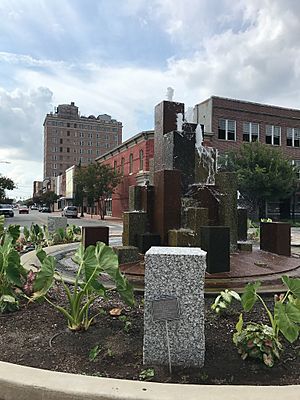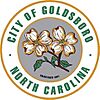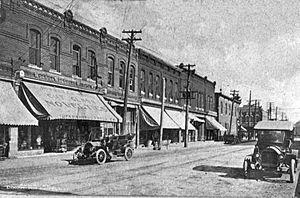Goldsboro, North Carolina facts for kids
Quick facts for kids
Goldsboro, North Carolina
|
|||
|---|---|---|---|

Center Street
|
|||
|
|||
| Motto(s):
"Be More, Do More, Seymour"
|
|||

Location of Goldsboro in North Carolina
|
|||
| Country | |||
| State | |||
| County | Wayne | ||
| Founded / Incorporated | 1787 / 1847 | ||
| Area | |||
| • City | 28.74 sq mi (74.45 km2) | ||
| • Land | 28.59 sq mi (74.05 km2) | ||
| • Water | 0.15 sq mi (0.40 km2) | ||
| Elevation | 108 ft (33 m) | ||
| Population
(2020)
|
|||
| • City | 33,657 | ||
| • Density | 1,177.23/sq mi (454.52/km2) | ||
| • Urban | 54,456 (US: 478th) | ||
| • Urban density | 1,024.4/sq mi (395.5/km2) | ||
| • Metro | 117,333 (US: 334th) | ||
| Time zone | UTC−5 (EST) | ||
| • Summer (DST) | UTC−4 (EDT) | ||
| ZIP codes |
27530-27534
|
||
| Area code(s) | 919, 984 | ||
| FIPS code | 37-26880 | ||
| GNIS feature ID | 2403709 | ||
Goldsboro is a city in Wayne County, North Carolina, United States. It is the main city of the Goldsboro Metropolitan Area. In 2020, about 33,657 people lived there.
The city is in North Carolina's flat Coastal Plain. The Neuse River borders it to the south, and the Little River to the west. Goldsboro is about 40 miles (64 km) southwest of Greenville. It is also about 50 miles (80 km) southeast of Raleigh, the state capital. Seymour Johnson Air Force Base is located right in Goldsboro.
Contents
History of Goldsboro
Around 1787, when Wayne County was created, a town called Waynesborough grew. It was built around the county's courthouse. This town became the county seat.
However, things changed when the Wilmington and Weldon Railroad was finished in the early 1840s. A hotel was built where the railroad crossed the New Bern Road. This spot quickly grew into a new community.
Many people moved from Waynesborough to this new, growing village. It was first called "Goldsborough's Junction" after Major Matthew T. Goldsborough, a railroad engineer. Later, the name was shortened to Goldsborough. In 1847, the town became an official city. It also became the new county seat for Wayne County after a public vote.
Goldsborough continued to grow thanks to new railroad lines connecting it to other cities. By 1861, about 1,500 people lived there. It became an important trading center for the surrounding farms.
Goldsboro During the Civil War
Because it was a major railroad hub, Goldsborough was very important during the Civil War. It was used to station Confederate troops and move their supplies. The city also had hospitals for wounded soldiers.
In December 1862, the Battle of Goldsborough Bridge took place. Both sides fought for control of the important Wilmington and Weldon Railroad Bridge. Union General John Foster wanted to destroy this bridge. He succeeded on December 17, burning it down. The important bridge was rebuilt in just a few weeks.
Goldsborough saw another Union attack in 1865. This happened during Union General Sherman's Carolinas Campaign. After some battles, Sherman's large army took over the city in March. For three weeks, over 100,000 Union soldiers occupied Goldsborough. Some troops stayed in the city even after the war ended.
Later History and Development
In 1869, the city's name was officially changed to Goldsboro. After the Civil War, Wayne County was part of a special area known as the "Black Second." This was because most of its population was Black. This area elected four Black Republican leaders to Congress in the 1800s.
A hospital for Black people with mental health needs was built in Goldsboro in the 1880s. It was called the State Hospital. This hospital operated until laws required all public places to be open to everyone.
During World War II, Seymour Johnson Air Force Base opened near Goldsboro in April 1942. This base helped the city's population and businesses grow. The base's name changed to Seymour Johnson AFB in 1947.
Today, Goldsboro is home to Goldsboro Milling Company. This company is one of the largest producers of hogs and turkeys in the U.S.
Several historic buildings in Goldsboro are listed on the National Register of Historic Places. These include the Borden Manufacturing Company and the First Presbyterian Church.
Nuclear Accident Near Goldsboro
In 1961, two large hydrogen bombs were accidentally dropped near the village of Faro, about 12 miles (19 km) north of Goldsboro. This happened after a B-52 aircraft broke apart in the air. The bombs were released, but luckily, neither of them exploded.
One bomb was found and recovered. Most of the second bomb was also found. However, a missing piece containing uranium sank deep into the swampy ground and could not be recovered. The Air Force bought the land where the piece is to keep it safe. In 2013, it was shared that three safety features on one bomb had failed. This meant only one switch prevented it from exploding.
Geography and Climate
Goldsboro covers about 24.8 square miles (64.2 km2) of land. Only a very small part is water.
The Neuse River forms the city's southern border. The Little River flows through the west side of the city. It joins the Neuse River about 2 miles (3.2 km) south of US 70. Stoney Creek runs through the east side of the city, near the Seymour Johnson Air Force Base.
The closest lakes are McArthur Lake, Cedar Lake, and Quaker Neck Lake. Quaker Neck Lake is man-made and helps cool the H.F. Lee Energy Complex.
Goldsboro's Weather
Goldsboro has a Humid subtropical climate. This means it has hot, humid summers and cool winters. July is the hottest month, with average high temperatures around 91°F (33°C). January is the coldest month, with average high temperatures around 54°F (12°C).
The city gets about 52.53 inches (1,334 mm) of rain each year. Rain falls fairly evenly throughout the year, with a bit more in late summer and early fall. Sometimes, there is light to moderate snowfall in winter. However, the amount of snow can change a lot from year to year.
| Climate data for GOLDSBORO 4 SE, NC, 1991-2020 normals | |||||||||||||
|---|---|---|---|---|---|---|---|---|---|---|---|---|---|
| Month | Jan | Feb | Mar | Apr | May | Jun | Jul | Aug | Sep | Oct | Nov | Dec | Year |
| Mean daily maximum °F (°C) | 54.2 (12.3) |
58.1 (14.5) |
65.1 (18.4) |
75.2 (24.0) |
81.8 (27.7) |
88.0 (31.1) |
91.0 (32.8) |
89.1 (31.7) |
83.4 (28.6) |
74.8 (23.8) |
65.5 (18.6) |
57.3 (14.1) |
73.6 (23.1) |
| Daily mean °F (°C) | 44.4 (6.9) |
47.3 (8.5) |
54.1 (12.3) |
63.1 (17.3) |
70.6 (21.4) |
78.4 (25.8) |
81.3 (27.4) |
80.0 (26.7) |
74.8 (23.8) |
64.3 (17.9) |
54.4 (12.4) |
47.3 (8.5) |
63.3 (17.4) |
| Mean daily minimum °F (°C) | 34.6 (1.4) |
36.4 (2.4) |
43.1 (6.2) |
51.0 (10.6) |
59.5 (15.3) |
68.8 (20.4) |
71.7 (22.1) |
70.8 (21.6) |
66.3 (19.1) |
53.9 (12.2) |
43.3 (6.3) |
37.3 (2.9) |
53.1 (11.7) |
| Average precipitation inches (mm) | 3.55 (90) |
3.24 (82) |
4.22 (107) |
3.90 (99) |
3.52 (89) |
4.40 (112) |
5.42 (138) |
6.42 (163) |
7.03 (179) |
3.79 (96) |
3.17 (81) |
3.60 (91) |
52.26 (1,327) |
| Average snowfall inches (cm) | 1.3 (3.3) |
0.0 (0.0) |
0.0 (0.0) |
0.0 (0.0) |
0.0 (0.0) |
0.0 (0.0) |
0.0 (0.0) |
0.0 (0.0) |
0.0 (0.0) |
0.0 (0.0) |
0.0 (0.0) |
0.7 (1.8) |
2.0 (5.1) |
| Average precipitation days (≥ 0.01 in) | 11.9 | 9.5 | 11.3 | 8.7 | 9.5 | 10.3 | 12.8 | 10.8 | 10.1 | 7.4 | 8.2 | 10.4 | 120.9 |
| Average snowy days (≥ 0.1 in) | 0.7 | 0.1 | 0.0 | 0.0 | 0.0 | 0.0 | 0.0 | 0.0 | 0.0 | 0.0 | 0.0 | 0.2 | 1.0 |
| Source: NOAA | |||||||||||||
Population of Goldsboro
| Historical population | |||
|---|---|---|---|
| Census | Pop. | %± | |
| 1860 | 885 | — | |
| 1870 | 1,134 | 28.1% | |
| 1880 | 3,286 | 189.8% | |
| 1890 | 4,017 | 22.2% | |
| 1900 | 5,877 | 46.3% | |
| 1910 | 6,107 | 3.9% | |
| 1920 | 11,296 | 85.0% | |
| 1930 | 14,985 | 32.7% | |
| 1940 | 17,274 | 15.3% | |
| 1950 | 21,454 | 24.2% | |
| 1960 | 28,873 | 34.6% | |
| 1970 | 26,960 | −6.6% | |
| 1980 | 31,871 | 18.2% | |
| 1990 | 40,709 | 27.7% | |
| 2000 | 39,043 | −4.1% | |
| 2010 | 36,437 | −6.7% | |
| 2020 | 33,657 | −7.6% | |
| U.S. Decennial Census | |||
2020 Census Information
| Race | Number | Percentage |
|---|---|---|
| White (non-Hispanic) | 10,931 | 32.48% |
| Black or African American (non-Hispanic) | 17,867 | 53.09% |
| Native American | 103 | 0.31% |
| Asian | 781 | 2.32% |
| Pacific Islander | 29 | 0.09% |
| Other/Mixed | 1,563 | 4.64% |
| Hispanic or Latino | 2,383 | 7.08% |
As of the 2020 United States census, Goldsboro had 33,657 people. There were 14,404 households and 8,320 families living in the city.
In 2019, about 52.7% of the people in Goldsboro were African American. About 39.9% were White. Other groups included Native American, Asian, Pacific Islander, and people of two or more races. About 5.8% of the population was Hispanic or Latino.
Fun Things to Do in Goldsboro
Places to Visit
- Cliffs of the Neuse State Park is a state park close to the city. It has 751 acres (3.04 km2) along the Neuse River. You can go swimming, hiking, or fishing there. The park also has a nature museum and picnic areas. The cliffs rise 90 feet (27 m) above the river.
- Waynesborough Historical Village is a recreated village. It is near where the original town of Waynesborough used to be. It has old buildings from Wayne County, like a family home, a doctor's office, and a one-room school.
- Herman Park is a great place for recreation. It has a miniature train, tennis courts, and picnic spots. There is also a gazebo, a goldfish pond, and a playground for kids.
- The Oheb Shalom synagogue is a very old building. It is one of the oldest synagogue buildings still standing in North Carolina.
Schools and Learning
Colleges and Universities
- North Carolina Wesleyan College Goldsboro campus
- Wayne Community College
High Schools in Goldsboro
- Eastern Wayne High School
- Goldsboro High School
- Rosewood High School
- Wayne Early/Middle College High School
- Wayne School of Engineering
- Charles B. Aycock High School
- Spring Creek High School
- Southern Wayne High School
- Wayne School of Technical Arts
Middle Schools in Goldsboro
- Dillard Middle School
- Eastern Wayne Middle School
- Greenwood Middle School
- Rosewood Middle School
- Brogden Middle School
- Norwayne Middle School
- Spring Creek Middle School
Elementary Schools in Goldsboro
- Carver Heights Elementary School
- Dillard Academy Charter School
- Eastern Wayne Elementary School
- Grantham Elementary School
- Meadow Lane Elementary School
- North Drive Elementary School
- Rosewood Elementary School
- School Street Early Learning Center
- Spring Creek Elementary School
- Tommy's Road Elementary School
Private Schools in Goldsboro
- Faith Christian Academy
- Pathway Christian Academy
- St. Mary Catholic School
- Wayne Christian School
- Wayne Country Day School
- Wayne Preparatory Academy
Media and News
Newspapers
- The Goldsboro News-Argus is the city's daily newspaper.
- Goldsboro Daily News is a free online daily newspaper.
Television
Goldsboro has one television station, WHFL TV 43. It shows religious, local, and family programs. The area also gets TV stations from Raleigh-Durham and Greenville. WNCN-TV, Channel 17, is licensed to Goldsboro but has its studios in Raleigh.
Radio Stations in Goldsboro
- WZKT 97.7 FM (Country music)
- WFMC 730 AM (Black Gospel music)
- WGBR 1150 AM (News/Talk radio)
- WSSG 1300 AM/92.7 FM (Urban music)
City Services and Transport
Transportation
The closest airport for general aviation is Wayne Executive Jetport. For public flights, most people use Raleigh-Durham International Airport.
Major highways that go through Goldsboro include US 70, US 13, and US 117. I-795 connects Goldsboro to I-95 in Wilson.
The Goldsboro Bypass, which is part of U.S. 70, opened in May 2016. It is now called Future Interstate 42.
The city has a bus system called Gateway with four routes.
Hospitals in Goldsboro
- Wayne Memorial Hospital (North Carolina) is a medical center in Goldsboro. It is the county's second-largest employer.
- Cherry Hospital is a hospital that helps people with mental health needs. It started in 1880. There is also a museum about its history on the hospital campus.
- O'Berry Neuro-Medical Center helps people with intellectual and developmental disabilities.
Famous People From Goldsboro
- George Altman, baseball player
- Dan Bullock, a young Marine who served in the Vietnam War
- Doris Coley, singer, member of The Shirelles
- Jimmy Graham, football player for the New Orleans Saints and Seattle Seahawks
- Johnny Grant, radio and TV personality, honorary mayor of Hollywood
- Andy Griffith, actor, taught at Goldsboro High School
- Anne Jeffreys, actress
- Clyde King, baseball pitcher and manager
- Jerry Narron, baseball catcher and coach
- Mark O'Meara, golfer who won the Masters and British Open
- Jarran Reed, NFL defensive tackle
- Kenneth Claiborne Royall, Army general and last Secretary of War
- Big Daddy V, former WWE wrestler
- Greg Warren, long snapper for the Pittsburgh Steelers
- Joby Warrick, winner of two Pulitzer Prizes
- Coby White, NBA basketball player for the Chicago Bulls
See also
 In Spanish: Goldsboro (Carolina del Norte) para niños
In Spanish: Goldsboro (Carolina del Norte) para niños






